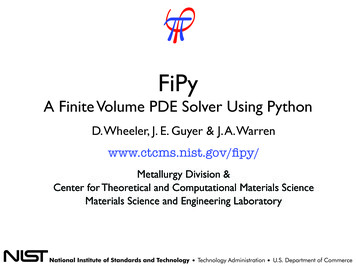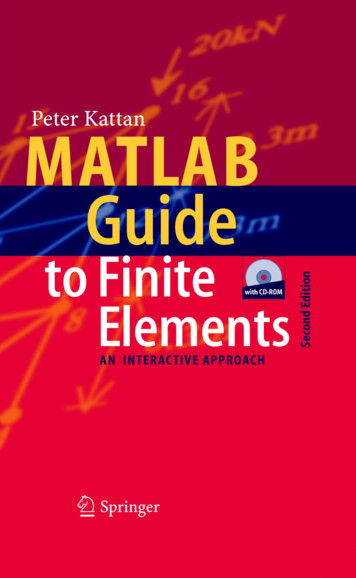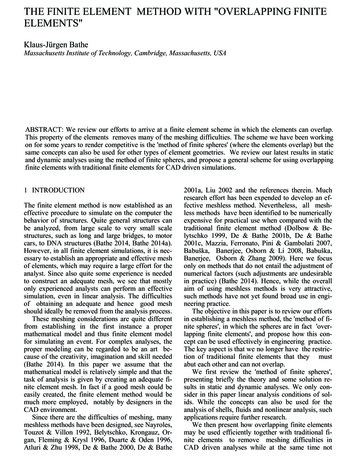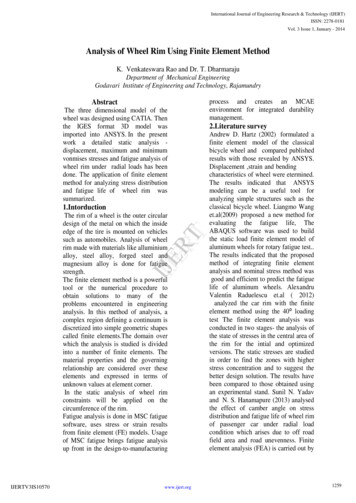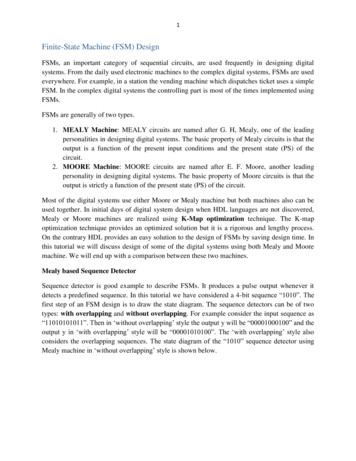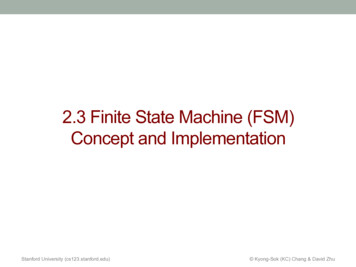
Transcription
2.3 Finite State Machine (FSM)Concept and ImplementationStanford University (cs123.stanford.edu) Kyong-Sok (KC) Chang & David Zhu
Topics Finite State Machine (FSM) What are FSM’s Why / When to use FSM Implementing of Finite State Machines Home Work Assignment (part 2)Stanford University (cs123.stanford.edu) Kyong-Sok (KC) Chang & David Zhu
What Is A Finite State Machine(a.k.a Finite-state Automaton)Stanford University (cs123.stanford.edu) Kyong-Sok (KC) Chang & David Zhu
An ExampleStanford University (cs123.stanford.edu) Kyong-Sok (KC) Chang & David Zhu
FSM Examples in Daily Live Vending Machines Traffic Lights Elevators Alarm Clock Microwave Cash RegistersEach of these devices can be thought of as a reactive system - thatis because each of them work by reacting to signals or inputs fromthe external world.Stanford University (cs123.stanford.edu) Kyong-Sok (KC) Chang & David Zhu
What Is A Finite State Machine A reactive system whose response to a particular stimulus(a signal, or a piece of input) is not the same on everyoccasion, depending on its current “state”. For example, in the case of a parking ticket machine, itwill not print a ticket when you press the button unless youhave already inserted some money. Thus the response tothe print button depends on the previous history of the useof the system.Stanford University (cs123.stanford.edu) Kyong-Sok (KC) Chang & David Zhu
More Precisely (Formally) A Finite State Machine is defined by (Σ,S,s0,δ,F), where: Σ is the input alphabet (a finite, non-empty set of symbols). S is a finite, non-empty set of states. s0 is an initial state, an element of S. δ is the state-transition function: δ : S x Σ S F is the set of final states, a (possibly empty) subset of S. O is the set (possibly empty) of outputsStanford University (cs123.stanford.edu) Kyong-Sok (KC) Chang & David Zhu
A (Simplified) Ticket Machine Σ (m, t, r) : inserting money, requesting ticket, requesting refundS (1, 2) : unpaid, paids0 (1) : an initial state, an element of S.δ (shown below) : transition function: δ : S x Σ SF : emptyO (p/d) : print ticket, deliver refundStanford University (cs123.stanford.edu) Kyong-Sok (KC) Chang & David Zhu
Acceptors and Transducers Acceptors: no output, have final states Transducers: non-empty set of outputAcceptorStanford University (cs123.stanford.edu)Transducer Kyong-Sok (KC) Chang & David Zhu
Deterministic and Non-Deterministic Non-deterministic: Competing “Transitions” Leaving SameStateWe only concern ourselves with Deterministic FSM in thisclassStanford University (cs123.stanford.edu) Kyong-Sok (KC) Chang & David Zhu
How To Implement an FSM The Finite State Machine class keeps track of the currentstate, and the list of valid state transitions. You define each transition by specifying : FromState - the starting state for this transition ToState - the end state for this transition condition - a callable which when it returns True means thistransition is valid callback - an optional callable function which is invoked when thistransition is executed.Stanford University (cs123.stanford.edu) Kyong-Sok (KC) Chang & David Zhu
Simplest FSMPress/click “b”StartABPress/click “a”Stanford University (cs123.stanford.edu) Kyong-Sok (KC) Chang & David Zhu
Why Finite State Machines For Robot Response to an event is dependent on the “state” of therobotTurn-left, turn-rightStanford University (cs123.stanford.edu) Kyong-Sok (KC) Chang & David Zhu
Two Robot Examples Obstacle Avoidance Example “Escape” ExampleStanford University (cs123.stanford.edu) Kyong-Sok (KC) Chang & David Zhu
Home Work #2-2: “Cleaner”(Push Out “Trash”) Trash: small white boxes,about same size as robot,very light No other obstacles insideboundary except trashStanford University (cs123.stanford.edu) Kyong-Sok (KC) Chang & David Zhu
Clean Out TrashStanford University (cs123.stanford.edu) Kyong-Sok (KC) Chang & David Zhu
HW Specification Push out trash to outside of boundary (black tape) – atleast half of the “box” is outside of boundary Indicate (with sound or light) that track has been pushedout Quit (success condition) after pushing 3 pieces of trashout Assumptions: No other object inside boundary except trash Trash are small white boxes about the same size as the robotStanford University (cs123.stanford.edu) Kyong-Sok (KC) Chang & David Zhu
Stanford University (cs123.stanford.edu) Kyong-Sok (KC) Chang & David Zhu 2.3 Finite State Machine (FSM) Concept and Implementation

